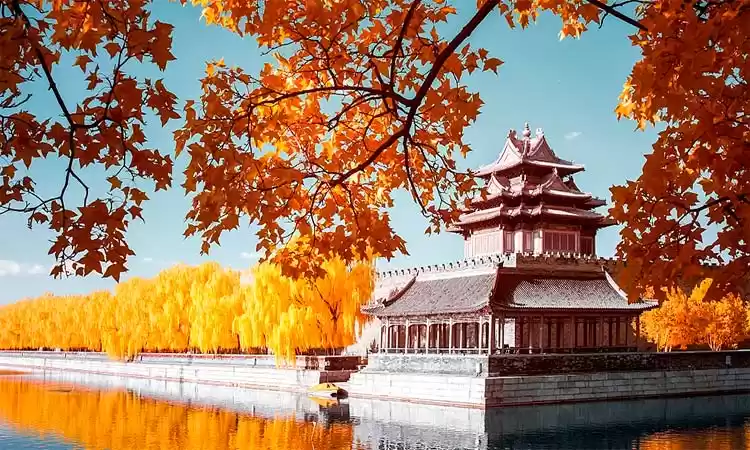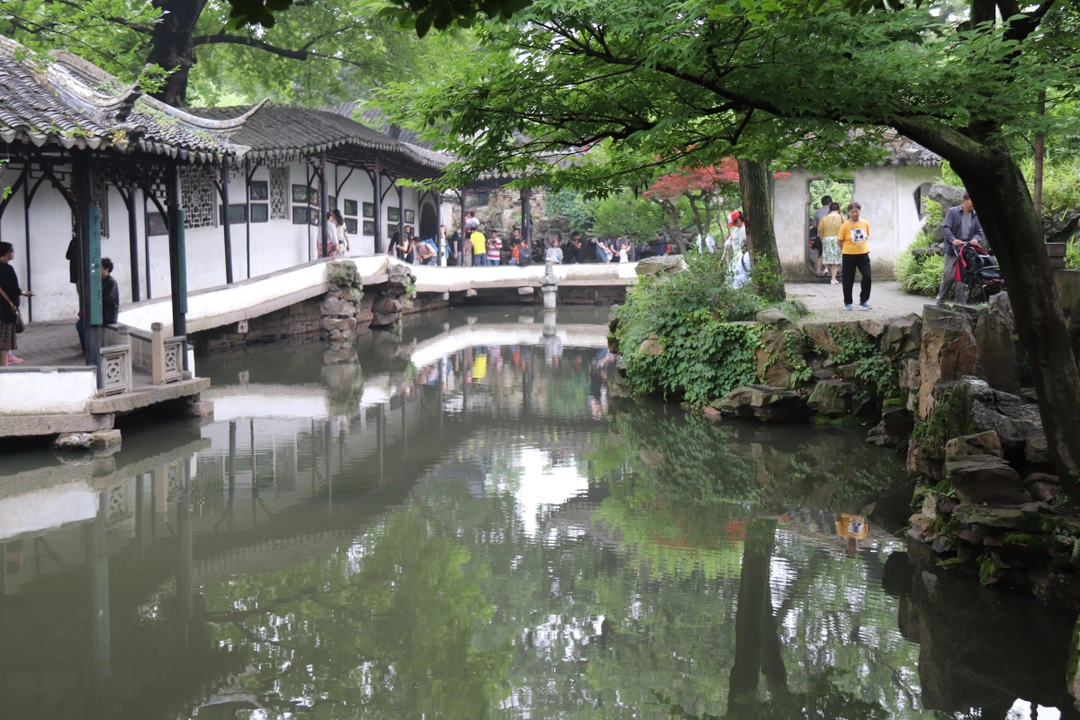
The craze for glass bridges in China is huge. Almost every month, a new bridge is opened to public. There are more than 40 glass bridges in China, built in spectacular scenic areas. I have been to about half a dozen glass bridges/walkways around Beijing and have witnessed couple of major ones away from Beijing. In an earlier blog, I had written about the tallest and second longest bridge, at Zhangjiajie ( https://china-diary.com/2019/05/30/a-dream-trip-to-zhangjiajie-the-avatar-mountains/). In this blog, I will try to describe our experience of the visiting the new, longest bridge at Hongyagu (red cliff valley) in Hebei province of China. This trip was also special due to the opportunity to get to know many aspects of Chinese culture.
This was a CET (Culture exchange trip) activity during the weekend of 9-10 March 2019. Hari showed interest and my friend at CET said this is a confirmed trip. The price was very reasonable, 510 RMB with the group discount. I booked for three of us, and we realized that there were only two more people other than us. We were wondering if the trip would get cancelled. Normally in the bus trips, if people are less than 10, they cancel as it doesn't workout for them. Luckily, CET said they will still go ahead with the trip. Instead of bus, we will be put on the train, which is even better.
The CET leader was Dan, and we were five people: I, Hema and Hari, Maite Morales, a Puerto Rican and Sheldon Cox, an American. We caught the train K21 from Beijing Xi to Shijiazhuang at 8:18. The journey was comfortable, and we reached at 11:55. At Shijiazhuang, there was a driver with a 7-seater car waiting for us. Drive to the resort where our hotel was, took about an hour. The hotel, Youth inn (青年客栈), was comfortable. We kept the bag at the room, freshened up and left for the village. After lunch in a local restaurant, we went to the culture school, Hongya Academy.


Two ladies got to wear Chinese traditional clothes. The teacher showed us how the greeting gestures used to be in ancient China. The fist and palm salute are a classic Chinese etiquette. Even now, Chinese people make fist and palm salutes when they are paying visit to someone during the traditional Chinese New Year, wedding reception, birthday or funeral. They say this started during the West Zhou Dynasty (BC 1046-BC 771). In this, first is standing at attention. For males it is right-hand half-fist, and then left hand holding the right hand in front of one's chest. Watch each other in the eyes, raise both hand to brow, bent down and shake hands toward each other gently for three times. One can also say some greetings like: "nǐ hǎo"(你好, hello), " xìnɡ huì"(幸会, very pleased to meet you), " xīn nián kuài lè"( 新年快乐, happy new year) etc. to each other based on the occasion. A thing to be noted is, this is different from the hold fist salute used in Kung Fu.

Next was an illustration of musical instruments, mainly drums and chimes (bells). The teacher showed how these were used in ancient times. Chinese chimes also originated in the Western Zhou Dynasty and became more popular during the Warring States period (770BC-221BC). The school had many different types of bells. This was an important instrument in ancient China. Made of bronze in different sizes and arranged in an order, to produce different music when hit with a wooden bar. These were played during feast, worship and other occasions. It can be used for solo or group singing and as a dance accompaniment. Our group tried their skills at both drums and bells.


After this was the demonstration of Chinese block printing technology. Much before the invention of the printing press in Europe, the Chinese developed a kind of printing using carved wooden blocks. This was also due to the earlier Chinese inventions, paper and ink. Movable type (活字印刷术) is an improved system. The world's first movable type printing press technology for printing paper books was made of clay materials and was invented around AD1040 in China during the Northern Song Dynasty by Bi Sheng.

The school has a large collection of the blocks. We all tried to print the poetry on white sheets provided and brought back the sheets as souvenirs.
The school has a section about the Traditional Chinese Medicine (TCM). Teacher explained with examples, the basics of TCM. With over 3000 years of experience, TCM is a key area in ancient Chinese culture. First known during the Yellow Emperor, TCM is believed to have been practiced in as early as 475 to 221 B.C. The basic principle of Traditional Chinese medicine believes that body is made of five elements i.e. metal, water, wood, fire and earth. An imbalance in these five elements is the cause of any illness in the body. The eight principles of differentiating diseases are yin (阴) and yang (阳), exterior (biao, 标) and interior (li, 里), xu (deficiency, 虚) and shi (excess, 实 ), and cold and heat. The teacher also explained various methods for maintaining balance in the body like acupressure and massages.









Around 17:00 we left the school and moved to the square in Hongya village. The street had shops that sold exotic food and mementoes. We roamed around for some time and then had dinner at a local restaurant. The town looked great at night with all the lighting. Dan said we will see a light show. What we witnessed was one of the most wonderful spectacles ever.
Group of people arranged coal fire in three places in the square and were heating something. Later I realized that in an alloy pot they were heating iron to melting. This is the famous 'Dashuhua' ( 打树花, hitting tree flowers) called so due to the molten iron resembling flowers falling from a tree when hit. The molten iron is picked up in a bamboo spoon and is hit with a paddle to create a large shower of starry sparks. It was an amazing spectacle for about two hours, with groups doing dragon dances and group daances along with it. Dashuhua is certainly a high risk, high skill ancient art form. The performers were asking people to keep away. In the enthusiasm to video shoot the event, I didn't even realize how my two T-shirts both got a hole in the back due to the molten iron!
Historically, Dashuhua started 500 years ago in the farming town of NuanQuan in Hebei. The town was poor and only the wealthy could afford put on a big firework display at the end of the lantern festival to mark the end of the celebration and to scare of the demons that may be on the way to village, so no harm would come to the towns and locals that year. The blacksmiths figured out that by splashing molten metal onto the walls of the city gates, they could create bright flower shapes like the firework effect. Over the years, the molten iron fireworks or Dashuhua performances have grown more popular and have overtaken the original fireworks display themselves. Other metals are also added now to make it more colorful.


After this there was "fast mask-changing"(biàn liǎn, 变脸) performance by an artist on the stage, as well as on ground for about half an hour. Bian Lian is an old dramatic art emerged during Qing dynasty, around 300 years ago, popular with Chinese opera from the Sichuan Province. It is considered a part of China's cultural heritage and is the only art form to be ranked as a level two national secret. The purpose of different masks is to show different feelings. The skill and speed with which the artist changes the beautifully-painted masks, has thrilled the audiences for centuries. Performers gracefully raise their hands, turn their heads and swing their arms, each time boasting a new mask. The secret of how they manage to change from three to twenty masks during a single performance without anyone realizing the trick is mind-blowing. It is said that this started with people painting their faces to scare the animals. According to a legend, there was a hero who stole from the rich and distributed to the poor, changed his face to avoid getting caught.



The artist showed brilliant moves and changed masks several times even before werealized. He also spit fire many times. When he came down, he did a shake hand with me, possibly because I was a foreigner. The whole atmosphere was electrifying.

We roamed around for some more time enjoying beauty of the village and went back to the hotel.
Next morning, we had typical Chinese breakfast at a nearby restaurant where many people were there. The restaurant had ancient Chinese poetry on its walls. We kept our bags in a common place and moved towards the glass bridge. It was quite a scenic walk to the site. There were wooden steps leading to a temple. The temple is beautiful and is in an amazing location. We spent some time at the temple and started climbing again. The steps were steep and Hema felt that it was tough. We reached the glass bridge at 10:20 and Dan distributed the tickets.

















Hongyagu Glass Suspension Bridge is at Hongyashan Scenic Area in Hebei Province, and links two peaks with the 488-meter long and 4-meter-wide glass suspension bridge. It officially opened to the public on Dec 24th, 2017. The bridge is constructed using suspended-cable structure and is made of 1,077 glass panels of four-centimeter thickness. It accommodates up to 600 people at the same time. It has a height of 218 meters and sways due to the suspension cables.






There were many people on the bridge as expected. Some were enjoying, while some were scared. The scene all around from the middle of the bridge was spectacular. We took many pictures there and did some jumps before a security man came and asked not to do it.
We came down and proceeded to Shijiazhuang railway station. We had some food at the station . We caught the train Z54 at 15:02 and reached Beijing at 17:32. Though just a weekend trip, the Hongyagu experience was amazing. The culture training, the Dashuhua fireworks, the fast mask changing and of course the longest glass bridge were all wonderful experiences. Being in a small group was nice and Dan, the leader managed everything very well. Thanks to her also for correcting some of the content in this blog. Thanks to CET for this nice opportunity.
























